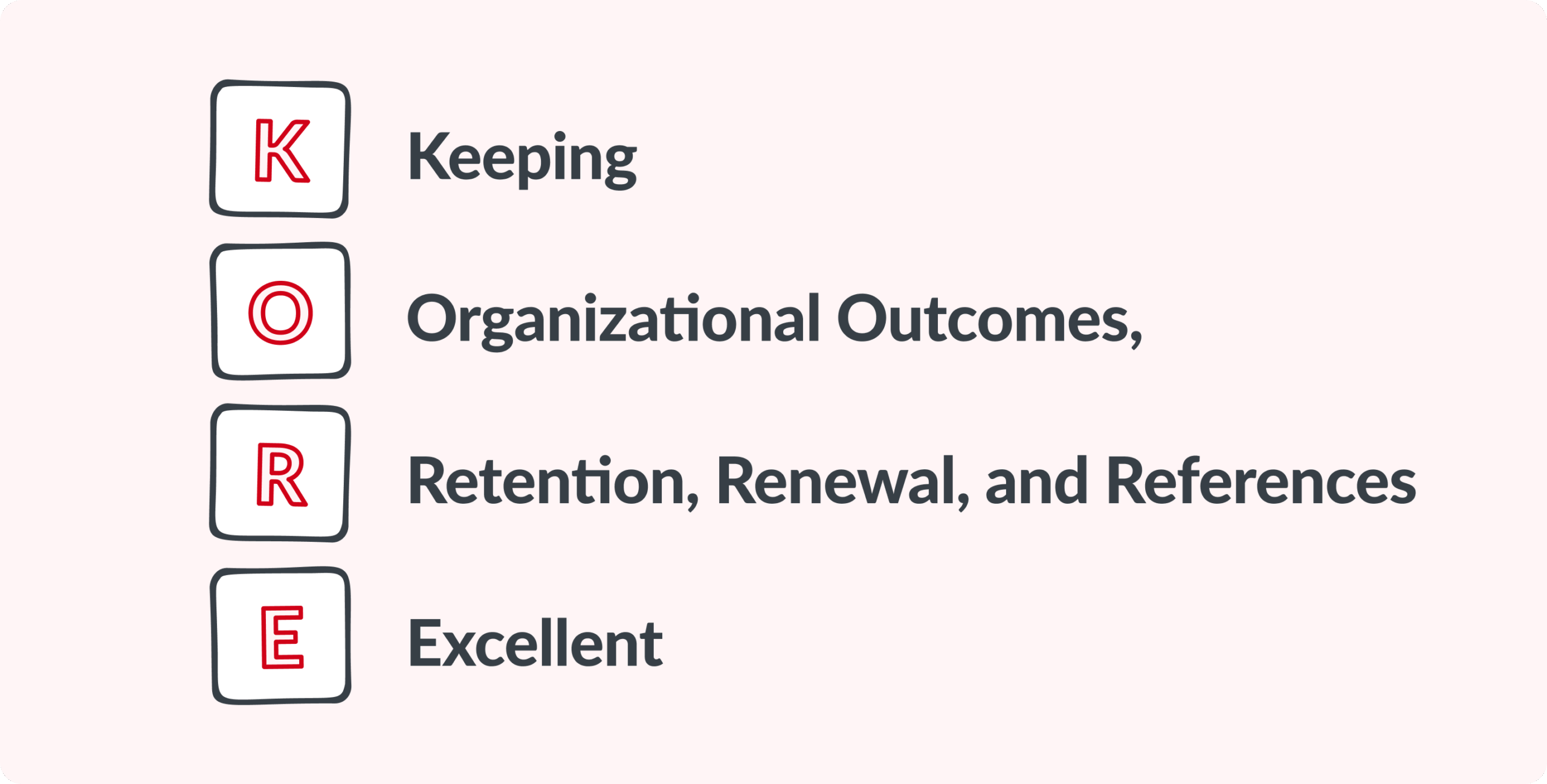If your team uses Net Promoter Score (NPS), you’re in good company. It’s one of the most widely adopted customer metrics in the world. NPS asks a single question: “How likely are you to recommend our company to a friend or colleague?” This measures overall customer sentiment and brand advocacy; it’s an important signal of trust, satisfaction, and loyalty.
But for CS teams, additional questions arise:
- Are customers actually achieving the outcomes they expected?
- How likely are they to renew or expand their relationship with us?
- Can we connect our metrics more directly to business outcomes?
- How do engaged decision-makers feel about the partnership?
- What other signals should we be paying attention to?
This has led to various additional frameworks being explored. One of those is the KORE Score, a structured approach developed to help CS teams assess account health.
What is the KORE framework?
The KORE Score is a customer success metric developed by the Technology & Services Industry Association (TSIA) in 2024. Its name is an acronym for:

KORE’s focus is to help CS leaders assess customer health based on business results, not just sentiment. It invites a broad, structured look at how the customer relationship is performing operationally.
It asks four targeted questions, each tied to a key business result:
| Dimension | What it measures | Question to ask |
|---|---|---|
| Outcome | Whether the customer is receiving the value they expected | What is the likelihood your company has already received expected outcomes? |
| Reference | Willingness to advocate for your brand | What is the likelihood your company would serve as a positive reference for us? |
| Renewal | Probability of renewing the current contract | What is the likelihood your company will renew at least 100% of the current value? |
| Retention | Likelihood of remaining a customer | What is the likelihood your company will remain a customer in the next renewal period? |
Each question is answered on a five-point scale (from “very unlikely” to “very likely”), and the average of those four scores becomes the customer’s KORE Score.
Why was this framework created?
Internal health scores may be opaque or inconsistent across teams. KORE offers a standardized, survey-based structure that’s easy to roll out but still rich enough to support real business decisions.
It’s also adaptable: teams with strong telemetry data (e.g. product usage or contract value) can blend that into the scoring, while others can rely entirely on survey inputs.
Importantly, KORE isn’t designed to replace sentiment metrics. It’s built to answer additional questions tied to long-term outcomes and account strategy.
What KORE measures differently
The KORE Score is outcome-oriented, and each question maps to a result that customer success teams are directly responsible for. By keeping the focus on signals of future customer behavior, KORE makes it easier to:
- Align your team around shared definitions of health
- Forecast risks and renewals with more confidence
- Build success plans based on tangible business goals
Here’s a quick look at what makes it a useful metric.
1. It supports structured, strategic reviews
Unlike a one-question pulse survey, KORE is well-suited to:
- Quarterly Business Reviews (QBRs)
- Executive check-ins
- Health score updates
- Renewal planning meetings
Because the questions are aligned with account outcomes, the responses naturally feed into discussions about expansion readiness, service gaps, product adoption, and reference potential.
2. It’s designed for decision-makers
While NPS is usually sent to individual users or support contacts, KORE surveys are designed to be completed by business owners, procurement leads, or executive sponsors. The idea is to get insight from the people who actually decide whether to renew!
This adds a layer of clarity to your health scoring. A happy day-to-day user might give you a high NPS — but that doesn’t always reflect the account’s business perception of value.
3. It offers clear thresholds for action
Because KORE uses a five-point Likert scale across four questions, the final score is easy to interpret. TSIA offers a tiered model to help teams take the right action at the right time:
| KORE Score | Status | Suggested next step |
|---|---|---|
| 4.3 – 5.0 | Pacesetter | Celebrate, invite to advocacy or expansio |
| 3.8 – 4.2 | On-Target High | Monitor and maintain strong engagement |
| 3.1 – 3.7 | On-Target Medium | Investigate gaps, realign on goals |
| 2.6 – 3.0 | On-Target Low | Flag for renewal risk, assign follow-up actions |
| 1.1 – 2.5 | Underperforming | Escalate to team lead, review Success Plan |
| 0.0 – 1.0 | Emergency | Consider executive outreach or recovery efforts |
The KORE framework provides an easy way to segment your customer base, using input from decision-makers.
How teams use both KORE and NPS together
Customer feedback isn’t one-dimensional, and neither are your goals. Most customer success leaders want to know how customers feel, what they intend to do, and why either of those things might change.
Each metric gives you part of the picture!
NPS shows sentiment: Are we trusted? Do people like the experience?
KORE shows intent: Will this customer stay? Are we delivering value?
Used together, they form a layered feedback system that supports both short-term action and long-term strategy.
A sample workflow: Where each metric fits
Let’s say your team runs a high-touch customer success program. Here’s how you might use both metrics throughout the customer journey:
| Stage | NPS Role | KORE role |
|---|---|---|
| Onboarding | Send NPS to track early impressions | N/A (KORE not typically used this early) |
| First value | Pulse NPS to capture product satisfaction | Begin initial KORE baseline with business sponsor |
| Quarterly review | Include recent NPS trend | Use KORE as core agenda (value, risk, readiness) |
| Pre-renewal | Use NPS to flag experience changes | Use KORE to forecast renewal and recommend next steps |
| Advocacy stage | Use NPS to identify promoters and secure testimonials | Use KORE to validate account health and references |
NPS helps you spot patterns in how customers feel. KORE helps you understand what they’re likely to do next. Together, they give you both awareness and direction.
In practice, here’s how teams bring KORE and NPS into their workflows:
- CSMs use NPS to track how end users feel after support/onboarding and KORE to shape strategic conversations with decision-makers.
- Marketing teams use NPS to find potential customer advocates, while KORE helps validate which accounts are truly healthy enough for case studies.
- CS leadership uses KORE scores in QBRs, dashboards, and forecasts, while NPS is used to monitor experience trends or brand trust over time.
Read more: How to ensure each team uses customer feedback to drive growth
Some companies build combined views in their CRM or CS platform. For example:
“This customer has a KORE score of 4.1 and an NPS of 9.
Let’s invite them to our referral program.”
vs.
“This customer has an NPS of 9, but a KORE score of 2.8.
Let’s check in with their exec sponsor before assuming they’re healthy.”
This kind of view brings multifaceted insights into a single conversation, helping teams track how customers feel with how they’re likely to act.
If the scores disagree (high NPS and low KORE Score, or vice versa), it means something is worth investigating. Do the customers like the product but question the ROI? Is the relationship strong, but the service is falling short? Are individual users happy, but the budget owner isn’t?
Seeing both metrics side-by-side helps you ask better questions and respond with precision.
The KORE of the matter
Using the KORE framework adds the most value when:
👉 You’re managing long-term, renewal-based contracts
👉 You’re expected to forecast churn and retention
👉 You want to improve the structure of account reviews and success planning
👉 You need a CS health score that aligns with revenue metrics
This metric empowers CS leaders. It fosters more meaningful, outcome-focused conversations. It is another way to keep track of danger signs and build lasting relationships.
If you’re thinking of applying the KORE Score, be prepared to reshape how you interpret account health, where you focus your team’s energy, and how you define success across the customer journey.
About Simplesat: Simplesat is the leading omnichannel survey app designed to enhance customer feedback management across various platforms, including Zendesk, Salesforce, and Gladly. Trusted by businesses worldwide, Simplesat delivers actionable insights that drive business growth and customer satisfaction.




